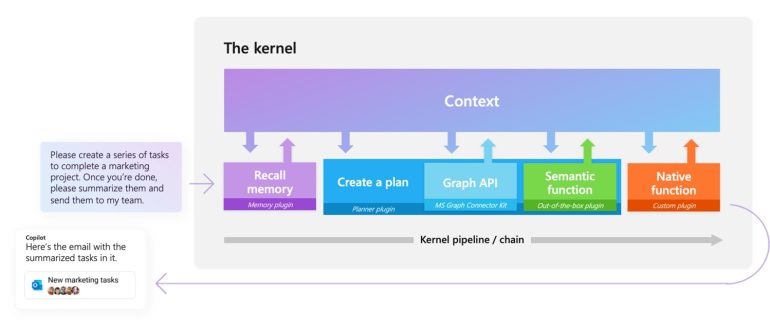- Microsoft unveils Semantic Kernel AI SDK for Python and Java, marking a significant milestone in AI integration.
- The SDK acts as an AI orchestration layer, seamlessly integrating large language model (LLM) technology into applications.
- Semantic Kernel facilitates the fusion of AI services like OpenAI, Azure OpenAI, and Hugging Face with conventional programming languages.
- Java SDK introduces groundbreaking features including Tool Calling, Audio Service Enhancements, Enhanced Type Conversion, and Advanced Hooks.
- Python SDK revolutionizes collaboration with features like Shared Prompts Across Languages and Cross-Language Prompt Sharing.
- Improved API consistency ensures alignment with Java principles and fosters cross-language development and knowledge sharing.
- Microsoft’s commitment to developer empowerment and innovation in AI integration is evident in the advancements made with Semantic Kernel SDK.
Main AI News:
Microsoft’s latest announcement marks a significant milestone in the realm of AI integration. At the forefront of this advancement is the Semantic Kernel AI SDK, now available for Python and Java. Unveiled during the recent Build 2024 developer conference, Semantic Kernel Python 1.0.0 and Semantic Kernel Java v1 bring unparalleled capabilities to developers worldwide.
The journey to this point has been marked by relentless innovation. With the C#/.NET SDK reaching v1.0.1 in December 2023, Microsoft shifted its focus towards enhancing the Python and Java versions. This strategic move underscores the company’s commitment to empowering developers with cutting-edge tools.
Semantic Kernel serves as a vital component within Microsoft’s Copilot stack of AI tools. It acts as an AI orchestration layer, seamlessly integrating state-of-the-art large language model (LLM) technology into applications. By providing interaction services, Semantic Kernel facilitates the utilization of Microsoft’s AI models and Copilot AI assistants.
The significance of Semantic Kernel transcends mere functionality. It represents a paradigm shift in AI development, enabling developers to merge AI services like OpenAI, Azure OpenAI, and Hugging Face with conventional programming languages such as C# and Python. This fusion results in the creation of AI applications that embody the best of both worlds.
Java: Pioneering Innovations in AI Integration
The release of Semantic Kernel Java v1 introduces a plethora of groundbreaking features tailored to enhance developer productivity and streamline AI integration. Among the notable additions are:
- Tool Calling: Empowering AI services to invoke native Java functions, thereby serving as a strategic planning mechanism.
- Audio Service Enhancements: Enabling seamless text-to-audio and audio-to-text conversions, expanding the scope of AI-driven applications.
- Enhanced Type Conversion: Facilitating the registration and serialization/deserialization of types, ensuring seamless data manipulation.
- Advanced Hooks: Providing developers with the ability to monitor critical points such as function calls, thereby enhancing tracking and debugging capabilities.
In addition to feature enhancements, Microsoft has prioritized API consistency, ensuring that the SDK adheres to Java principles while maintaining compatibility with Java 8 and later versions. This alignment with Java standards, coupled with improved naming conventions mirroring the .NET SDK, fosters cross-language development and knowledge sharing across teams.
Python: Revolutionizing Collaboration and Efficiency
Parallel to the advancements in Java, Semantic Kernel Python undergoes a transformative evolution, redefining collaboration and efficiency in AI development. Key highlights of the latest release include:
- Shared Prompts Across Languages: Facilitating seamless prompt sharing across different programming languages, fostering collaboration and consistency.
- Cross-Language Prompt Sharing: Enhancing efficiency by enabling consistent prompts across diverse programming environments, thereby streamlining development workflows.
Furthermore, the Python team has revamped documentation and sample code structures to accelerate the onboarding process for developers. With an array of syntax examples on the horizon, developers can harness the full potential of the SDK and embark on their AI journey with confidence.
Conclusion:
The advent of Semantic Kernel AI SDK in Python and Java signifies a watershed moment in AI integration. With its unparalleled capabilities and commitment to developer empowerment, Microsoft continues to spearhead innovation in the AI landscape. As developers embrace these cutting-edge tools, the boundaries of what’s possible in AI-driven applications are bound to be pushed further, ushering in a new era of technological advancement and collaboration.

